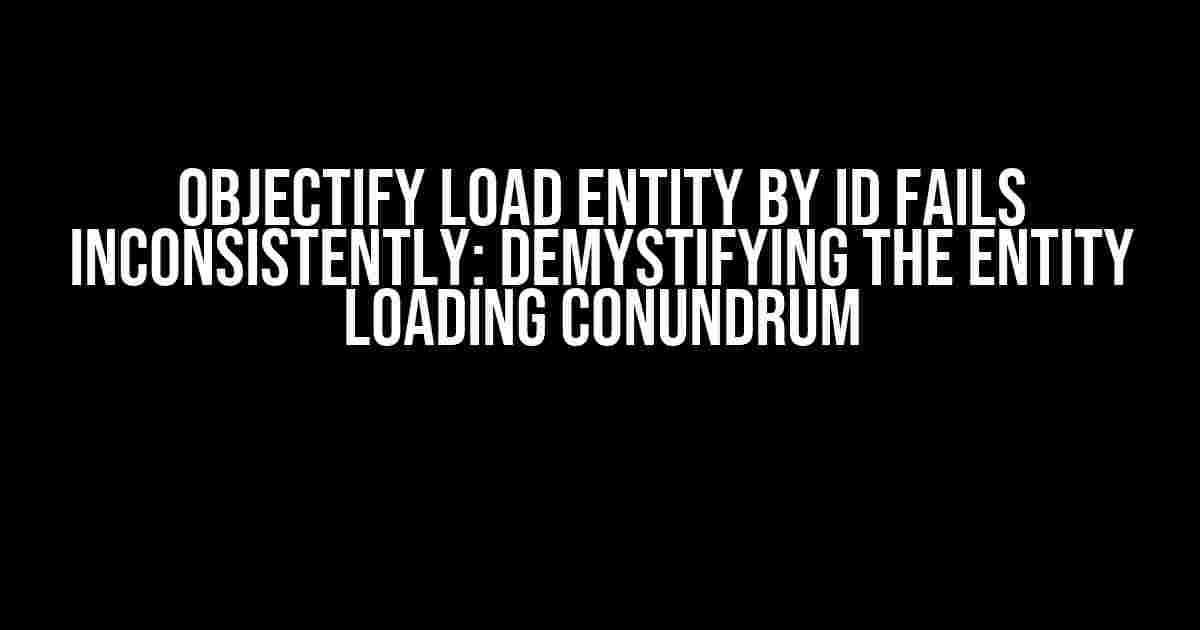Imagine this: you’re working on a crucial project, and suddenly, you’re faced with an error that seems to defy all logic. You’ve written flawless code, but somehow, Objectify’s Load Entity by ID functionality decides to fail inconsistently. The frustration is palpable, and you’re left wondering what dark magic is at play. Fear not, dear developer, for we’re about to embark on a journey to unravel the mysteries surrounding this enigmatic issue.
Understanding the Basics of Objectify
Before we dive into the troubleshooting waters, let’s take a step back and review the fundamentals of Objectify. Objectify is a Java-based Object-Relational Mapping (ORM) tool designed for Google App Engine (GAE). It simplifies data storage and retrieval by allowing you to interact with your data using Java classes, rather than raw GAE datastore APIs.
Objectify’s Load Entity by ID method is a crucial feature that enables you to fetch an entity from the datastore based on its unique identifier. However, when this method fails inconsistently, it can be a real showstopper. So, what’s going on?
Common Causes of Inconsistent Failure
After digging deep into the trenches of Objectify’s Load Entity by ID woes, we’ve identified some common culprits behind this issue. Take a closer look at the following potential causes:
- Incorrect Entity Annotations: Verify that your entity class is properly annotated with the
@Entityand@Idannotations. Ensure that the@Idannotation is applied to the correct field. - Field Type Mismatch: Double-check that the field type in your entity class matches the type expected by Objectify. For example, if your entity has a Long ID, ensure that the field is declared as a Long, not an int or long.
- NULL or Empty ID: Make sure that the ID you’re passing to the Load Entity by ID method is not NULL or empty. This might seem obvious, but it’s an easy mistake to overlook.
- Inconsistent Datastore Data: It’s possible that the data in your datastore is corrupted or inconsistent. Try checking the datastore for any anomalies or data corruption.
- Objectify Configuration Issues: Review your Objectify configuration settings to ensure that they’re correct. Pay attention to the entity registry, as incorrect settings can lead to Load Entity by ID failures.
Troubleshooting Steps to Debug Load Entity by ID Issues
Now that we’ve covered the common causes, let’s walk through some step-by-step troubleshooting steps to help you debug Load Entity by ID issues:
-
Enable Objectify’s Debug Mode: Add the following configuration to your Objectify setup:
ObjectifyService.factory().setLogger(new ConsoleLogger());
This will enable debug logging, providing more detailed information about the Load Entity by ID method.
-
Verify Entity Annotations and Fields: Double-check that your entity class is correctly annotated with the
@Entityand@Idannotations. Also, ensure that the field types match the expected types. -
Check the Datastore for Corruption: Inspect the datastore for any signs of data corruption or inconsistencies. You can use the GAE Datastore Viewer or a third-party tool to examine the data.
-
Use Objectify’s built-in Caching Mechanism: If you’re using Objectify’s caching mechanism, try disabling it to see if it resolves the issue. You can do this by setting the caching policy to
CachingPolicy disabled(). -
Test with a Simple Entity: Create a minimal entity class with a single field (e.g., a Long ID) and try loading it using the Load Entity by ID method. If this works, then the issue might be specific to your original entity class.
-
Inspect Objectify’s Cache: If you’re using caching, inspect the cache contents to ensure that the entity is being cached correctly. You can use Objectify’s
getCache"method to retrieve the cache instance. -
Check for Entity Version Conflicts: If you’re using entity versioning, ensure that the versions are being incremented correctly. Try loading the entity with the correct version number to see if it resolves the issue.
Real-World Scenarios and Solutions
Let’s explore some real-world scenarios where Objectify’s Load Entity by ID method fails inconsistently and how to solve them:
| Scenario | Solution |
|---|---|
| Entity with a Composite ID | Ensure that the composite ID is correctly annotated with the @Id annotation, and that the field types match the expected types. |
| Entity with a Parent Entity | Verify that the parent entity is correctly annotated with the @Parent annotation, and that the parent entity’s ID is being passed correctly to the Load Entity by ID method. |
| Entity with a Large Amount of Data | Consider using Objectify’s fetch() method to load a subset of the entity’s fields, reducing the amount of data being loaded. |
Conclusion
Objectify’s Load Entity by ID method is a powerful tool for fetching entities from the datastore, but when it fails inconsistently, it can be frustrating and confusing. By understanding the common causes, troubleshooting steps, and real-world scenarios, you’ll be better equipped to tackle this issue head-on.
Remember, when debugging Load Entity by ID issues, take a systematic approach, and don’t be afraid to dig deep into the Objectify configuration, entity annotations, and data corruption. With persistence and patience, you’ll uncover the root cause of the issue and find a solution to get your project back on track.
In the world of Objectify, sometimes it’s the smallest oversights that lead to the biggest headaches. But by following this guide, you’ll be well-prepared to navigate the complex landscape of Load Entity by ID failures and emerge victorious, with your Objectify-powered project running smoothly and efficiently.
Frequently Asked Question
Having trouble with objectify load entity by id? Don’t worry, we’ve got you covered! Here are some frequently asked questions and answers to help you troubleshoot the issue.
Why does objectify load entity by id fail inconsistently?
There could be several reasons why objectify load entity by id fails inconsistently. One possible reason is that the entity might not be fully loaded or cached, leading to intermittent failures. Another reason could be that there are concurrent modifications to the entity, causing the load operation to fail.
How can I troubleshoot the issue of objectify load entity by id failing inconsistently?
To troubleshoot the issue, you can try enabling debug logging to see if there are any errors or warnings related to the load operation. You can also try using the Objectify caches to see if the entity is being cached correctly. Additionally, you can try using a transaction to load the entity, which can help to ensure that the load operation is atomic.
What is the difference between Objectify’s load() and get()
Objectify’s load() and get() methods both load entities from the datastore, but they have different behaviors. The load() method loads the entity from the datastore and returns a fully populated entity, while the get() method returns a lightweight reference to the entity, which can be used to load the entity later. If you’re experiencing issues with load entity by id, try using the get() method instead.
Can I use Objectify’s caching to improve the performance of load entity by id?
Yes, you can use Objectify’s caching to improve the performance of load entity by id. Objectify provides a caching mechanism that can cache entities in memory, which can reduce the number of trips to the datastore. You can configure the caching behavior to cache entities for a certain amount of time, which can improve performance.
Are there any best practices for using Objectify to load entities by id?
Yes, there are several best practices for using Objectify to load entities by id. One best practice is to use the load() method instead of the get() method, as load() returns a fully populated entity. Another best practice is to use transactions to load entities, which can ensure that the load operation is atomic. Additionally, you should consider using caching to improve performance.


